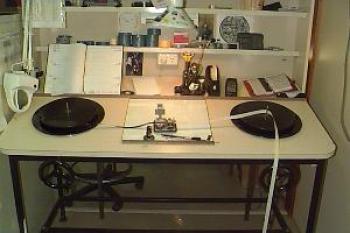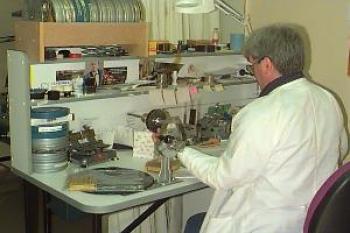
Winders
Film winders fall into two broad categories, horizontal and vertical. In the horizontal winder, the circular disc against which the film is wound is horizontal, like a gramophone turntable. In the vertical winder, it is vertical like a vehicle wheel. These two arrangements each have their advantages and disadvantages.

Advantages of horizontal winder:
Some films are received loosely wound, and some films if damaged can only be wound loosely. In this case, gravity pulls the whole reel down onto the turntable, and it is not liable to try to spill. All the film is near the surface of the winding bench and may be found easier to manoeuvre. Most horizontal winders have a low gear ratio between the winding handle and the turntable (commonly 2:1). This gives better control over the wind. Vertical winders are usually geared higher (commonly 3:1 or 4:1).

Advantages of vertical winder:
Some operators find it easier to look down through the film, with the plane of the film horizontal. If it is necessary to wind more than one film, as in synchronizing, the vertical arrangement lends itself to use of a long spindle on which two or more spools can be mounted. These can be manually or electrically operated.
The National Film and Sound Archive of Australia acknowledges Australia’s Aboriginal and Torres Strait Islander peoples as the Traditional Custodians of the land on which we work and live and gives respect to their Elders both past and present.


